Deck 13: Monopolistic Competition: the Competitive Model in a More Realistic Setting
Question
Question
Question
Question
Question
Question
Question
Question
Question
Question
Question
Question
Question
Question
Question
Question
Question
Question
Question
Question
Question
Question
Question
Question
Question
Question
Question
Question
Question
Question
Question
Question
Question
Question
Question
Question
Question
Question
Question
Question
Question
Question
Question
Question
Question
Question
Question
Question
Question
Question
Question
Question
Question
Question
Question
Question
Question
Question
Question
Question
Question
Question
Question
Question
Question
Question
Question
Question
Question
Question
Question
Question
Question
Question
Question
Question
Question
Question
Question
Question

Unlock Deck
Sign up to unlock the cards in this deck!
Unlock Deck
Unlock Deck
1/143
Play
Full screen (f)
Deck 13: Monopolistic Competition: the Competitive Model in a More Realistic Setting
1
When a monopolistically competitive firm lowers its price,one good thing happens to the firm.What is this "one good thing" called?
A)the output effect
B)the price effect
C)the income effect
D)the substitution effect
A)the output effect
B)the price effect
C)the income effect
D)the substitution effect
the output effect
2
In the United States,the average person mostly patronizes firms that operate in
A)perfectly competitive markets.
B)monopolistically competitive markets.
C)oligopoly markets.
D)monopoly markets.
A)perfectly competitive markets.
B)monopolistically competitive markets.
C)oligopoly markets.
D)monopoly markets.
monopolistically competitive markets.
3
For the monopolistically competitive firm,
A)Price (P)= Marginal Revenue (MR)= Average Revenue (AR).
B)P = MR > AR.
C)P = AR > MR.
D)P > MR = AR.
A)Price (P)= Marginal Revenue (MR)= Average Revenue (AR).
B)P = MR > AR.
C)P = AR > MR.
D)P > MR = AR.
P = AR > MR.
4
Because the monopolistically competitive firm faces a ________ demand curve for its product,it ________ the price of its output.
A)downward-sloping; cannot influence
B)horizontal; can influence
C)horizontal; cannot influence
D)downward-sloping; can influence
A)downward-sloping; cannot influence
B)horizontal; can influence
C)horizontal; cannot influence
D)downward-sloping; can influence

Unlock Deck
Unlock for access to all 143 flashcards in this deck.
Unlock Deck
k this deck
5
Which of the following characterizes the market that Starbucks competes in?
A)All coffeehouses face horizontal demand curves.
B)Coffeehouses sell identical products.
C)Barriers to entry are low.
D)There are a small number of firms.
A)All coffeehouses face horizontal demand curves.
B)Coffeehouses sell identical products.
C)Barriers to entry are low.
D)There are a small number of firms.

Unlock Deck
Unlock for access to all 143 flashcards in this deck.
Unlock Deck
k this deck
6
Which of the following is not a characteristic of monopolistic competition?
A)There are many buyers and sellers.
B)There are low barriers to entry.
C)Average revenue is equal to price.
D)The products sold by all firms are identical.
A)There are many buyers and sellers.
B)There are low barriers to entry.
C)Average revenue is equal to price.
D)The products sold by all firms are identical.

Unlock Deck
Unlock for access to all 143 flashcards in this deck.
Unlock Deck
k this deck
7
When a monopolistically competitive firm lowers it price one bad thing happens to the firm.What is this "one bad thing" called?
A)the output effect
B)the income effect
C)the substitution effect
D)the price effect
A)the output effect
B)the income effect
C)the substitution effect
D)the price effect

Unlock Deck
Unlock for access to all 143 flashcards in this deck.
Unlock Deck
k this deck
8
When a firm faces a downward-sloping demand curve,marginal revenue
A)must exceed price because the price effect outweighs the output effect.
B)is less than price because a firm must lower its price to sell more.
C)equals price because the firm sells a standardized product.
D)must exceed price because the output effect outweighs the price effect.
A)must exceed price because the price effect outweighs the output effect.
B)is less than price because a firm must lower its price to sell more.
C)equals price because the firm sells a standardized product.
D)must exceed price because the output effect outweighs the price effect.

Unlock Deck
Unlock for access to all 143 flashcards in this deck.
Unlock Deck
k this deck
9
Figure 13-1 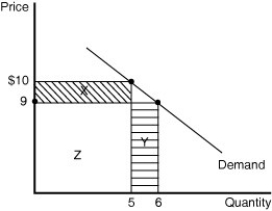
Refer to Figure 13-1.The marginal revenue from one additional unit sold is the sum of the gain in revenue from selling the additional unit and the loss in revenue from having to charge a lower price to sell the additional unit.Based on the diagram in the figure,
A)X represents the gain (price effect)and Y the loss (output effect).
B)X + Z represents the loss (output effect)and Y the gain (price effect).
C)Y represents the gain (output effect)and X the loss (price effect).
D)X represents the loss (price effect)and Y + Z the gain (output effect).

Refer to Figure 13-1.The marginal revenue from one additional unit sold is the sum of the gain in revenue from selling the additional unit and the loss in revenue from having to charge a lower price to sell the additional unit.Based on the diagram in the figure,
A)X represents the gain (price effect)and Y the loss (output effect).
B)X + Z represents the loss (output effect)and Y the gain (price effect).
C)Y represents the gain (output effect)and X the loss (price effect).
D)X represents the loss (price effect)and Y + Z the gain (output effect).

Unlock Deck
Unlock for access to all 143 flashcards in this deck.
Unlock Deck
k this deck
10
Which of the following is the best example of a firm that competes in a monopolistically competitive market?
A)the U.S.Postal Service
B)Microsoft
C)a movie theater
D)an automobile manufacturer
A)the U.S.Postal Service
B)Microsoft
C)a movie theater
D)an automobile manufacturer

Unlock Deck
Unlock for access to all 143 flashcards in this deck.
Unlock Deck
k this deck
11
The marginal revenue of a monopolistically competitive firm
A)cannot be negative because the price the firm charges will always be greater than zero.
B)can be negative if the firm charges a high price.
C)can be negative if the firm charges a low price.
D)will equal average revenue.
A)cannot be negative because the price the firm charges will always be greater than zero.
B)can be negative if the firm charges a high price.
C)can be negative if the firm charges a low price.
D)will equal average revenue.

Unlock Deck
Unlock for access to all 143 flashcards in this deck.
Unlock Deck
k this deck
12
Monopolistic competition is a market structure in which
A)firms produce and sell products for which there are no close substitutes.
B)the demand curve for a typical firm is horizontal.
C)firms cannot influence the market price.
D)barriers to entry are low.
A)firms produce and sell products for which there are no close substitutes.
B)the demand curve for a typical firm is horizontal.
C)firms cannot influence the market price.
D)barriers to entry are low.

Unlock Deck
Unlock for access to all 143 flashcards in this deck.
Unlock Deck
k this deck
13
Which of the following is not a characteristic of monopolistic competition?
A)Firms are price takers.
B)There are many buyers and sellers.
C)Barriers to entry are low.
D)Firms sell similar,but not identical,products.
A)Firms are price takers.
B)There are many buyers and sellers.
C)Barriers to entry are low.
D)Firms sell similar,but not identical,products.

Unlock Deck
Unlock for access to all 143 flashcards in this deck.
Unlock Deck
k this deck
14
If a monopolistically competitive firm lowers its price and,as a result,its total revenue decreases then
A)the output effect of the price change was less than the price effect.
B)the output effect of the price change was greater than the price effect.
C)the firm's demand curve must have decreased.
D)the substitution effect of the price change was greater than the income effect.
A)the output effect of the price change was less than the price effect.
B)the output effect of the price change was greater than the price effect.
C)the firm's demand curve must have decreased.
D)the substitution effect of the price change was greater than the income effect.

Unlock Deck
Unlock for access to all 143 flashcards in this deck.
Unlock Deck
k this deck
15
In San Francisco there are many restaurants that specialize in a wide variety of cuisines.Patronage at these restaurants is influenced by factors such as tastes,price and location.This market is
A)perfectly competitive.
B)monopolistically competitive.
C)oligopolistic.
D)monopolistic.
A)perfectly competitive.
B)monopolistically competitive.
C)oligopolistic.
D)monopolistic.

Unlock Deck
Unlock for access to all 143 flashcards in this deck.
Unlock Deck
k this deck
16
Figure 13-1 
Refer to Figure 13-1.What is the marginal revenue of the sixth unit of output?
A)$4
B)$5
C)$9
D)$54

Refer to Figure 13-1.What is the marginal revenue of the sixth unit of output?
A)$4
B)$5
C)$9
D)$54

Unlock Deck
Unlock for access to all 143 flashcards in this deck.
Unlock Deck
k this deck
17
The Jeans Store sells 7 pairs of jeans per day when it charges $100 per pair.It sells 8 pairs of jeans per day at a price of $90 per pair.The marginal revenue of the eighth pair of jeans is
A)$20.
B)$90.
C)$100.
D)$700.
A)$20.
B)$90.
C)$100.
D)$700.

Unlock Deck
Unlock for access to all 143 flashcards in this deck.
Unlock Deck
k this deck
18
A monopolistically competitive market is described as one in which there are
A)a few firms producing an identical product.
B)a large number of firms selling similar,but not identical,products.
C)a few firms producing differentiated products.
D)one large firm and many small firms producing identical products.
A)a few firms producing an identical product.
B)a large number of firms selling similar,but not identical,products.
C)a few firms producing differentiated products.
D)one large firm and many small firms producing identical products.

Unlock Deck
Unlock for access to all 143 flashcards in this deck.
Unlock Deck
k this deck
19
Which of the following describes a difference between the marginal revenue and demand curves of a perfectly competitive firm and a monopolistically competitive firm?
A)The perfectly competitive firm's marginal revenue and demand curves are the same; the marginal revenue curve of a monopolistically competitive firm lies above its demand curve.
B)The perfectly competitive firm's marginal revenue and demand curves are the same; the marginal revenue curve of a monopolistically competitive firm lies below its demand curve.
C)The monopolistically competitive firm's marginal revenue and demand curves are the same; the marginal revenue curve of a perfectly competitive firm lies below its demand curve.
D)The marginal revenue curve of a monopolistically competitive firm lies below its demand curve; the marginal revenue curve of a perfectly competitive firm lies above its demand curve.
A)The perfectly competitive firm's marginal revenue and demand curves are the same; the marginal revenue curve of a monopolistically competitive firm lies above its demand curve.
B)The perfectly competitive firm's marginal revenue and demand curves are the same; the marginal revenue curve of a monopolistically competitive firm lies below its demand curve.
C)The monopolistically competitive firm's marginal revenue and demand curves are the same; the marginal revenue curve of a perfectly competitive firm lies below its demand curve.
D)The marginal revenue curve of a monopolistically competitive firm lies below its demand curve; the marginal revenue curve of a perfectly competitive firm lies above its demand curve.

Unlock Deck
Unlock for access to all 143 flashcards in this deck.
Unlock Deck
k this deck
20
Starbucks started out small in 1971,but by 1993 Starbucks was a national chain and had coffeehouses in 38 countries.A key to the company's success was the realization by executives that
A)there was a demand for coffeehouses where consumers could sit and drink high-quality coffee.
B)coffee prices would have to be cut in order for Starbucks to compete with other stores that sold coffee.
C)they had to keep their stores open longer hours to attract a large number of customers.
D)their stores should be located close to other stores that sold similar products.
A)there was a demand for coffeehouses where consumers could sit and drink high-quality coffee.
B)coffee prices would have to be cut in order for Starbucks to compete with other stores that sold coffee.
C)they had to keep their stores open longer hours to attract a large number of customers.
D)their stores should be located close to other stores that sold similar products.

Unlock Deck
Unlock for access to all 143 flashcards in this deck.
Unlock Deck
k this deck
21
There are many cattle ranchers in the world,and there are also many McDonald's restaurants in the world.Why,then,does a McDonald's restaurant face a downward sloping demand curve while a cattle rancher faces a horizontal demand curve?

Unlock Deck
Unlock for access to all 143 flashcards in this deck.
Unlock Deck
k this deck
22
Figure 13-2 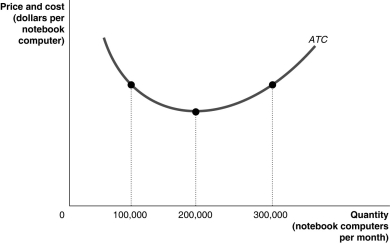
Refer to Figure 13-2.Suppose Dell finds the relationship between the average total cost of producing notebook computers and the quantity of notebook computers produced is as shown by Figure 13-2.Dell will maximize profits if it produces ________ notebook computers per month.
A)100,000
B)200,000
C)300,000
D)Not enough information is given to determine the profit-maximizing quantity.

Refer to Figure 13-2.Suppose Dell finds the relationship between the average total cost of producing notebook computers and the quantity of notebook computers produced is as shown by Figure 13-2.Dell will maximize profits if it produces ________ notebook computers per month.
A)100,000
B)200,000
C)300,000
D)Not enough information is given to determine the profit-maximizing quantity.

Unlock Deck
Unlock for access to all 143 flashcards in this deck.
Unlock Deck
k this deck
23
Firms in monopolistic competition compete by selling similar,but not identical products.

Unlock Deck
Unlock for access to all 143 flashcards in this deck.
Unlock Deck
k this deck
24
Every firm that has the ability to affect the price of the good or service it sells will
A)have a perfectly elastic demand curve.
B)have a marginal revenue curve that lies below its demand curve.
C)earn a short-run profit but break even in the long run.
D)shut down in the short run.
A)have a perfectly elastic demand curve.
B)have a marginal revenue curve that lies below its demand curve.
C)earn a short-run profit but break even in the long run.
D)shut down in the short run.

Unlock Deck
Unlock for access to all 143 flashcards in this deck.
Unlock Deck
k this deck
25
Both monopolistically competitive firms and perfectly competitive firms maximize profits
A)by producing where price equals average total cost.
B)by producing where marginal revenue equals average revenue.
C)by producing where marginal revenue is equal to marginal cost.
D)by producing where price equals average variable cost.
A)by producing where price equals average total cost.
B)by producing where marginal revenue equals average revenue.
C)by producing where marginal revenue is equal to marginal cost.
D)by producing where price equals average variable cost.

Unlock Deck
Unlock for access to all 143 flashcards in this deck.
Unlock Deck
k this deck
26
The demand curve of a monopolistically competitive firm
A)is horizontal because the firm must cut its price to sell more.
B)is perfectly elastic.
C)is downward-sloping because it sells an identical product.
D)is downward-sloping because it must cut its price to sell more.
A)is horizontal because the firm must cut its price to sell more.
B)is perfectly elastic.
C)is downward-sloping because it sells an identical product.
D)is downward-sloping because it must cut its price to sell more.

Unlock Deck
Unlock for access to all 143 flashcards in this deck.
Unlock Deck
k this deck
27
A monopolistically competitive firm maximizes profit in the short run by producing where
A)price is less than marginal cost.
B)price is less than marginal revenue.
C)price is less than average revenue.
D)price is greater than marginal cost.
A)price is less than marginal cost.
B)price is less than marginal revenue.
C)price is less than average revenue.
D)price is greater than marginal cost.

Unlock Deck
Unlock for access to all 143 flashcards in this deck.
Unlock Deck
k this deck
28
Suppose that if a local McDonald's restaurant reduces the price of a Big Mac from $4.00 to $3.25,the number of Big Macs it sells per day will increase from 4 to 5.Explain the output effect and the price effect resulting from this change.Using a graph,illustrate both the loss in revenue from selling each of the first 4 Big Macs for $0.75 less and the additional revenue from selling 1 more Big Mac.What is the total change in revenue received which results from this price decrease?

Unlock Deck
Unlock for access to all 143 flashcards in this deck.
Unlock Deck
k this deck
29
Table 13-1
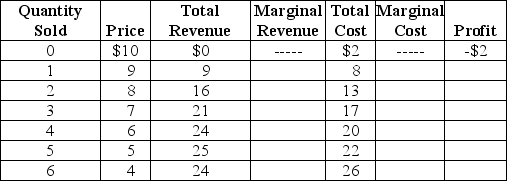 Table 13-1 lists estimated revenues and costs (per week)for plastic vials (100 vials per box)for the Victoria Biological Supplies Company.Victoria sells plastic vials to university and private research laboratories.
Table 13-1 lists estimated revenues and costs (per week)for plastic vials (100 vials per box)for the Victoria Biological Supplies Company.Victoria sells plastic vials to university and private research laboratories.
Refer to Table 13-1.Based on the data in the table,which of the following statements is true?
A)The table summarizes Victoria's short-run,rather than long-run,market for plastic vials.
B)Victoria could be either a monopolistically competitive or a perfectly competitive firm.
C)Victoria should shut down temporarily.
D)Victoria should advertise more in order to increase the demand for plastic vials.
 Table 13-1 lists estimated revenues and costs (per week)for plastic vials (100 vials per box)for the Victoria Biological Supplies Company.Victoria sells plastic vials to university and private research laboratories.
Table 13-1 lists estimated revenues and costs (per week)for plastic vials (100 vials per box)for the Victoria Biological Supplies Company.Victoria sells plastic vials to university and private research laboratories.Refer to Table 13-1.Based on the data in the table,which of the following statements is true?
A)The table summarizes Victoria's short-run,rather than long-run,market for plastic vials.
B)Victoria could be either a monopolistically competitive or a perfectly competitive firm.
C)Victoria should shut down temporarily.
D)Victoria should advertise more in order to increase the demand for plastic vials.

Unlock Deck
Unlock for access to all 143 flashcards in this deck.
Unlock Deck
k this deck
30
A monopolistically competitive firm chooses
A)both the quantity of output to produce and the price at which it will sell its output.
B)the price of the product it sells but market forces determine the quantity it will be able to sell.
C)the quantity of output to produce but the price of the product it sells is determined collectively by all firms in the industry.
D)the price of the product it sells but the quantity of output to produce is agreed upon by all firms in the industry.
A)both the quantity of output to produce and the price at which it will sell its output.
B)the price of the product it sells but market forces determine the quantity it will be able to sell.
C)the quantity of output to produce but the price of the product it sells is determined collectively by all firms in the industry.
D)the price of the product it sells but the quantity of output to produce is agreed upon by all firms in the industry.

Unlock Deck
Unlock for access to all 143 flashcards in this deck.
Unlock Deck
k this deck
31
One of the assumptions of monopolistic competition is that firms produce differentiated products.What does this assumption imply about the demand curve facing a representative firm?

Unlock Deck
Unlock for access to all 143 flashcards in this deck.
Unlock Deck
k this deck
32
Table 13-1
 Table 13-1 lists estimated revenues and costs (per week)for plastic vials (100 vials per box)for the Victoria Biological Supplies Company.Victoria sells plastic vials to university and private research laboratories.
Table 13-1 lists estimated revenues and costs (per week)for plastic vials (100 vials per box)for the Victoria Biological Supplies Company.Victoria sells plastic vials to university and private research laboratories.
Refer to Table 13-1.Victoria's profit-maximizing quantity sold (Q)and price (P)are:
A)Q = 3; P = $7.
B)Q = 4; P = $6.
C)Q = 5; P = $5.
D)Q = 6; P = $4.
 Table 13-1 lists estimated revenues and costs (per week)for plastic vials (100 vials per box)for the Victoria Biological Supplies Company.Victoria sells plastic vials to university and private research laboratories.
Table 13-1 lists estimated revenues and costs (per week)for plastic vials (100 vials per box)for the Victoria Biological Supplies Company.Victoria sells plastic vials to university and private research laboratories.Refer to Table 13-1.Victoria's profit-maximizing quantity sold (Q)and price (P)are:
A)Q = 3; P = $7.
B)Q = 4; P = $6.
C)Q = 5; P = $5.
D)Q = 6; P = $4.

Unlock Deck
Unlock for access to all 143 flashcards in this deck.
Unlock Deck
k this deck
33
New firms are able to enter monopolistically competitive markets because there are low barriers to entry.

Unlock Deck
Unlock for access to all 143 flashcards in this deck.
Unlock Deck
k this deck
34
Which of the following statements is true?
A)The marginal revenue of a monopolistically competitive firm will be positive at high prices and negative at low prices.
B)Because the demand curve for a monopolistically competitive firm is downward-sloping its marginal revenue will be negative.
C)The marginal revenue of a monopolistically competitive firm will be always be positive.
D)The marginal revenue of a monopolistically competitive firm will be positive at low prices and negative at high prices.
A)The marginal revenue of a monopolistically competitive firm will be positive at high prices and negative at low prices.
B)Because the demand curve for a monopolistically competitive firm is downward-sloping its marginal revenue will be negative.
C)The marginal revenue of a monopolistically competitive firm will be always be positive.
D)The marginal revenue of a monopolistically competitive firm will be positive at low prices and negative at high prices.

Unlock Deck
Unlock for access to all 143 flashcards in this deck.
Unlock Deck
k this deck
35
Table 13-1
 Table 13-1 lists estimated revenues and costs (per week)for plastic vials (100 vials per box)for the Victoria Biological Supplies Company.Victoria sells plastic vials to university and private research laboratories.
Table 13-1 lists estimated revenues and costs (per week)for plastic vials (100 vials per box)for the Victoria Biological Supplies Company.Victoria sells plastic vials to university and private research laboratories.
Refer to Table 13-1.Victoria's profit-maximizing output is where
A)total profit equals $3.
B)marginal revenue and marginal cost both equal $4.
C)marginal revenue and marginal cost both equal $3.
D)marginal cost is at its minimum value.
 Table 13-1 lists estimated revenues and costs (per week)for plastic vials (100 vials per box)for the Victoria Biological Supplies Company.Victoria sells plastic vials to university and private research laboratories.
Table 13-1 lists estimated revenues and costs (per week)for plastic vials (100 vials per box)for the Victoria Biological Supplies Company.Victoria sells plastic vials to university and private research laboratories.Refer to Table 13-1.Victoria's profit-maximizing output is where
A)total profit equals $3.
B)marginal revenue and marginal cost both equal $4.
C)marginal revenue and marginal cost both equal $3.
D)marginal cost is at its minimum value.

Unlock Deck
Unlock for access to all 143 flashcards in this deck.
Unlock Deck
k this deck
36
For a downward-sloping demand curve,marginal revenue decreases as quantity sold increases.

Unlock Deck
Unlock for access to all 143 flashcards in this deck.
Unlock Deck
k this deck
37
Suppose a monopolistically competitive firm sells 25 units at a price of $10.Calculate its marginal revenue per unit of output if it sells 5 more units of output when it reduced its price to $9.
A)$270.
B)$20
C)$4
D)$2.50
A)$270.
B)$20
C)$4
D)$2.50

Unlock Deck
Unlock for access to all 143 flashcards in this deck.
Unlock Deck
k this deck
38
After selling 1,000 three-ring binders Tony DiFulvio realizes that the marginal revenue from selling the last binder was less than the marginal cost.From this we can conclude that
A)Tony's business earns a short-run economic profit.
B)Tony should shut down his business temporarily.
C)Tony's profit fell after selling his 1,000th three-ring binder.
D)Tony's profit would be greater if he sold an additional three-ring binder.
A)Tony's business earns a short-run economic profit.
B)Tony should shut down his business temporarily.
C)Tony's profit fell after selling his 1,000th three-ring binder.
D)Tony's profit would be greater if he sold an additional three-ring binder.

Unlock Deck
Unlock for access to all 143 flashcards in this deck.
Unlock Deck
k this deck
39
Why are demand and marginal revenue represented by the same curve for a firm in a perfectly competitive market,but by separate curves for a firm in a monopolistically competitive market?

Unlock Deck
Unlock for access to all 143 flashcards in this deck.
Unlock Deck
k this deck
40
Monopolistically competitive firms face a perfectly elastic demand curve.

Unlock Deck
Unlock for access to all 143 flashcards in this deck.
Unlock Deck
k this deck
41
Table 13-2
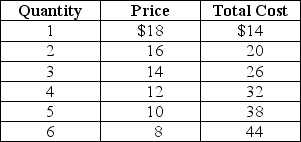 Table 13-2 shows the demand and cost data facing a monopolistically competitive producer of canvas bags.
Table 13-2 shows the demand and cost data facing a monopolistically competitive producer of canvas bags.
Refer to Table 13-2.What are the firm's profit-maximizing or loss-minimizing price and quantity?
A)price = $10; quantity = 5.
B)price = $12; quantity = 4.
C)The firm should shut down temporarily.
D)This cannot be determined from the information given.
 Table 13-2 shows the demand and cost data facing a monopolistically competitive producer of canvas bags.
Table 13-2 shows the demand and cost data facing a monopolistically competitive producer of canvas bags.Refer to Table 13-2.What are the firm's profit-maximizing or loss-minimizing price and quantity?
A)price = $10; quantity = 5.
B)price = $12; quantity = 4.
C)The firm should shut down temporarily.
D)This cannot be determined from the information given.

Unlock Deck
Unlock for access to all 143 flashcards in this deck.
Unlock Deck
k this deck
42
Suppose a monopolistically competitive firm's output where marginal revenue equals marginal cost is 66 units and the price corresponding to this quantity is $18.If the average total cost at this output is $16.55,then its total profit is
A)$1,188.
B)$1,092.30.
C)$95.70.
D)$1.45.
A)$1,188.
B)$1,092.30.
C)$95.70.
D)$1.45.

Unlock Deck
Unlock for access to all 143 flashcards in this deck.
Unlock Deck
k this deck
43
Figure 13-4 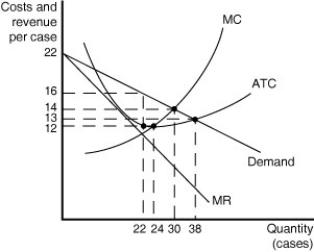 Figure 13-4 shows cost and demand curves for a monopolistically competitive producer of iced-tea.
Figure 13-4 shows cost and demand curves for a monopolistically competitive producer of iced-tea.
Refer to Figure 13-4.At the profit-maximizing output level the firm will
A)earn a profit of $176.
B)break even.
C)earn a profit of $88.
D)earn a profit of $60.
 Figure 13-4 shows cost and demand curves for a monopolistically competitive producer of iced-tea.
Figure 13-4 shows cost and demand curves for a monopolistically competitive producer of iced-tea.Refer to Figure 13-4.At the profit-maximizing output level the firm will
A)earn a profit of $176.
B)break even.
C)earn a profit of $88.
D)earn a profit of $60.

Unlock Deck
Unlock for access to all 143 flashcards in this deck.
Unlock Deck
k this deck
44
Figure 13-5 
Refer to Figure 13-5.Which of the graphs in the figure depicts a monopolistically competitive firm that is earning economic profits?
A)Panel A
B)Panel B
C)Panel C
D)Panel A and Panel B

Refer to Figure 13-5.Which of the graphs in the figure depicts a monopolistically competitive firm that is earning economic profits?
A)Panel A
B)Panel B
C)Panel C
D)Panel A and Panel B

Unlock Deck
Unlock for access to all 143 flashcards in this deck.
Unlock Deck
k this deck
45
If a perfectly competitive firm maximizes short-run profits,its marginal revenue will be positive and less than its price.

Unlock Deck
Unlock for access to all 143 flashcards in this deck.
Unlock Deck
k this deck
46
If a monopolistically competitive firm is producing 50 units of output where marginal cost equals marginal revenue,total cost is $1,674 and total revenue is $2,000,its average profit is
A)$326.
B)$40.
C)$6.52.
D)impossible to determine without additional information.
A)$326.
B)$40.
C)$6.52.
D)impossible to determine without additional information.

Unlock Deck
Unlock for access to all 143 flashcards in this deck.
Unlock Deck
k this deck
47
A profit-maximizing monopolistically competitive firm produces and sells an allocatively efficient quantity of output.

Unlock Deck
Unlock for access to all 143 flashcards in this deck.
Unlock Deck
k this deck
48
Figure 13-3 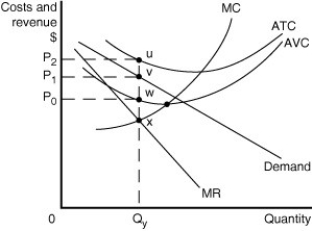 Figure 13-3 shows short-run cost and demand curves for a monopolistically competitive firm in the footwear market.
Figure 13-3 shows short-run cost and demand curves for a monopolistically competitive firm in the footwear market.
Refer to Figure 13-3.Which of the following is the area that represents the profit or loss experienced by the firm?
A)A loss represented by the rectangle P2uvP1.
B)A loss represented by the rectangle P2uwP0.
C)A loss represented by the rectangle P1vwP0.
D)An accounting profit equal to P1vwP0.
 Figure 13-3 shows short-run cost and demand curves for a monopolistically competitive firm in the footwear market.
Figure 13-3 shows short-run cost and demand curves for a monopolistically competitive firm in the footwear market.Refer to Figure 13-3.Which of the following is the area that represents the profit or loss experienced by the firm?
A)A loss represented by the rectangle P2uvP1.
B)A loss represented by the rectangle P2uwP0.
C)A loss represented by the rectangle P1vwP0.
D)An accounting profit equal to P1vwP0.

Unlock Deck
Unlock for access to all 143 flashcards in this deck.
Unlock Deck
k this deck
49
Figure 13-3  Figure 13-3 shows short-run cost and demand curves for a monopolistically competitive firm in the footwear market.
Figure 13-3 shows short-run cost and demand curves for a monopolistically competitive firm in the footwear market.
Refer to Figure 13-3.Which of the following statements describes the best course of action for the firm depicted in the diagram?
A)The firm should exit the industry because its price is less than its average total cost.
B)The firm should minimize its losses by producing Qy units and charging a price of P0.
C)The firm should minimize its losses by producing Qy units and charging a price of P2.
D)The firm should minimize its losses by producing Qy units and charging a price of P1.
 Figure 13-3 shows short-run cost and demand curves for a monopolistically competitive firm in the footwear market.
Figure 13-3 shows short-run cost and demand curves for a monopolistically competitive firm in the footwear market.Refer to Figure 13-3.Which of the following statements describes the best course of action for the firm depicted in the diagram?
A)The firm should exit the industry because its price is less than its average total cost.
B)The firm should minimize its losses by producing Qy units and charging a price of P0.
C)The firm should minimize its losses by producing Qy units and charging a price of P2.
D)The firm should minimize its losses by producing Qy units and charging a price of P1.

Unlock Deck
Unlock for access to all 143 flashcards in this deck.
Unlock Deck
k this deck
50
Figure 13-4  Figure 13-4 shows cost and demand curves for a monopolistically competitive producer of iced-tea.
Figure 13-4 shows cost and demand curves for a monopolistically competitive producer of iced-tea.
Refer to Figure 13-4.What is the firm's profit-maximizing price?
A)$12
B)$13
C)$14
D)$16
 Figure 13-4 shows cost and demand curves for a monopolistically competitive producer of iced-tea.
Figure 13-4 shows cost and demand curves for a monopolistically competitive producer of iced-tea.Refer to Figure 13-4.What is the firm's profit-maximizing price?
A)$12
B)$13
C)$14
D)$16

Unlock Deck
Unlock for access to all 143 flashcards in this deck.
Unlock Deck
k this deck
51
Table 13-2
 Table 13-2 shows the demand and cost data facing a monopolistically competitive producer of canvas bags.
Table 13-2 shows the demand and cost data facing a monopolistically competitive producer of canvas bags.
Refer to Table 13-2.At the profit-maximizing or loss-minimizing output level
A)the firm makes a profit of $12.
B)the firm incurs a loss equal to its fixed cost.
C)the firm makes a profit of $16.
D)the firm incurs a loss of $14.
 Table 13-2 shows the demand and cost data facing a monopolistically competitive producer of canvas bags.
Table 13-2 shows the demand and cost data facing a monopolistically competitive producer of canvas bags.Refer to Table 13-2.At the profit-maximizing or loss-minimizing output level
A)the firm makes a profit of $12.
B)the firm incurs a loss equal to its fixed cost.
C)the firm makes a profit of $16.
D)the firm incurs a loss of $14.

Unlock Deck
Unlock for access to all 143 flashcards in this deck.
Unlock Deck
k this deck
52
Figure 13-4  Figure 13-4 shows cost and demand curves for a monopolistically competitive producer of iced-tea.
Figure 13-4 shows cost and demand curves for a monopolistically competitive producer of iced-tea.
Refer to Figure 13-4.What is the profit-maximizing output level?
A)22 cases
B)24 cases
C)30 cases
D)38 cases
 Figure 13-4 shows cost and demand curves for a monopolistically competitive producer of iced-tea.
Figure 13-4 shows cost and demand curves for a monopolistically competitive producer of iced-tea.Refer to Figure 13-4.What is the profit-maximizing output level?
A)22 cases
B)24 cases
C)30 cases
D)38 cases

Unlock Deck
Unlock for access to all 143 flashcards in this deck.
Unlock Deck
k this deck
53
Unlike a perfectly competitive firm,a monopolistic competitor does not have a short-run shut-down point.

Unlock Deck
Unlock for access to all 143 flashcards in this deck.
Unlock Deck
k this deck
54
Table 13-1
 Table 13-1 lists estimated revenues and costs (per week)for plastic vials (100 vials per box)for the Victoria Biological Supplies Company.Victoria sells plastic vials to university and private research laboratories.
Table 13-1 lists estimated revenues and costs (per week)for plastic vials (100 vials per box)for the Victoria Biological Supplies Company.Victoria sells plastic vials to university and private research laboratories.
Refer to Table 13-1.At Victoria's profit-maximizing output
A)profit equals $2.
B)total revenue equals $24 and total cost equals $20.
C)total revenue equals $25 and total cost equals $22.
D)total revenue equals $21 and total cost equals $17.
 Table 13-1 lists estimated revenues and costs (per week)for plastic vials (100 vials per box)for the Victoria Biological Supplies Company.Victoria sells plastic vials to university and private research laboratories.
Table 13-1 lists estimated revenues and costs (per week)for plastic vials (100 vials per box)for the Victoria Biological Supplies Company.Victoria sells plastic vials to university and private research laboratories.Refer to Table 13-1.At Victoria's profit-maximizing output
A)profit equals $2.
B)total revenue equals $24 and total cost equals $20.
C)total revenue equals $25 and total cost equals $22.
D)total revenue equals $21 and total cost equals $17.

Unlock Deck
Unlock for access to all 143 flashcards in this deck.
Unlock Deck
k this deck
55
A monopolistically competitive firm is producing an output level where marginal revenue is greater than marginal cost.What should this firm do to increase its profit or reduce its losses?
A)The firm should raise its price.
B)The firm should decrease its fixed costs.
C)The firm should increase its implicit costs.
D)The firm should lower its price.
A)The firm should raise its price.
B)The firm should decrease its fixed costs.
C)The firm should increase its implicit costs.
D)The firm should lower its price.

Unlock Deck
Unlock for access to all 143 flashcards in this deck.
Unlock Deck
k this deck
56
Figure 13-4  Figure 13-4 shows cost and demand curves for a monopolistically competitive producer of iced-tea.
Figure 13-4 shows cost and demand curves for a monopolistically competitive producer of iced-tea.
Refer to Figure 13-4.Based on the diagram,one can conclude that
A)some existing firms will exit the market.
B)new firms will enter the market.
C)the industry is in long-run equilibrium.
D)firms achieve productive efficiency.
 Figure 13-4 shows cost and demand curves for a monopolistically competitive producer of iced-tea.
Figure 13-4 shows cost and demand curves for a monopolistically competitive producer of iced-tea.Refer to Figure 13-4.Based on the diagram,one can conclude that
A)some existing firms will exit the market.
B)new firms will enter the market.
C)the industry is in long-run equilibrium.
D)firms achieve productive efficiency.

Unlock Deck
Unlock for access to all 143 flashcards in this deck.
Unlock Deck
k this deck
57
A monopolistically competitive firm should lower its price if its marginal revenue exceeds its marginal cost.

Unlock Deck
Unlock for access to all 143 flashcards in this deck.
Unlock Deck
k this deck
58
Figure 13-6 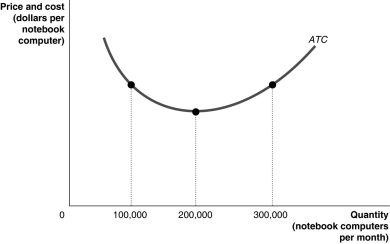
Refer to Figure 13-6.Suppose the above graph represents the relationship between the average total cost of producing notebook computers and the quantity of notebook computers produced by Dell.On a graph,illustrate the demand,MR,MC,and ATC curves which would represent Dell maximizing profits at a quantity of 100,000 per month and identify the area on the graph which represents the profit.

Refer to Figure 13-6.Suppose the above graph represents the relationship between the average total cost of producing notebook computers and the quantity of notebook computers produced by Dell.On a graph,illustrate the demand,MR,MC,and ATC curves which would represent Dell maximizing profits at a quantity of 100,000 per month and identify the area on the graph which represents the profit.

Unlock Deck
Unlock for access to all 143 flashcards in this deck.
Unlock Deck
k this deck
59
The profit-maximizing rule for a monopolistically competitive firm is to select the quantity at which
A)marginal revenue equals marginal cost.
B)average revenue exceeds marginal cost by the greatest amount.
C)price equals marginal cost.
D)average revenue equals average total cost.
A)marginal revenue equals marginal cost.
B)average revenue exceeds marginal cost by the greatest amount.
C)price equals marginal cost.
D)average revenue equals average total cost.

Unlock Deck
Unlock for access to all 143 flashcards in this deck.
Unlock Deck
k this deck
60
Figure 13-5 
Refer to Figure 13-5.Which of the graphs in the figure depicts a monopolistically competitive firm that is minimizing its losses?
A)Panel A
B)Panel B
C)Panel C
D)Panel A and Panel C

Refer to Figure 13-5.Which of the graphs in the figure depicts a monopolistically competitive firm that is minimizing its losses?
A)Panel A
B)Panel B
C)Panel C
D)Panel A and Panel C

Unlock Deck
Unlock for access to all 143 flashcards in this deck.
Unlock Deck
k this deck
61
One reason Starbucks experienced a decline in sales in the late 2000s is because
A)the product they offered was becoming less differentiated from their competitors' products.
B)the coffeehouse market transitioned from being monopolistically competitive to perfectly competitive.
C)barriers to entry became more restrictive in the coffeehouse market.
D)the number of competitors in the market declined dramatically.
A)the product they offered was becoming less differentiated from their competitors' products.
B)the coffeehouse market transitioned from being monopolistically competitive to perfectly competitive.
C)barriers to entry became more restrictive in the coffeehouse market.
D)the number of competitors in the market declined dramatically.

Unlock Deck
Unlock for access to all 143 flashcards in this deck.
Unlock Deck
k this deck
62
Figure 13-8 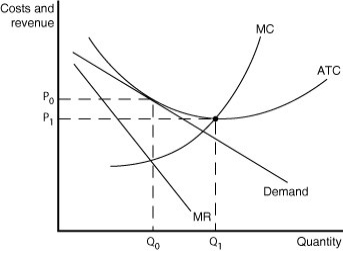 Figure 13-8 illustrates a monopolistically competitive firm.
Figure 13-8 illustrates a monopolistically competitive firm.
Refer to Figure 13-8.It is possible to lower the average cost of production by expanding output beyond Q0 to Q1.Why wouldn't a firm expand its output to Q1?
A)The firm wants to maximize accounting profit rather than economic profit.
B)The firm would suffer an economic loss at Q1 while it would break even at Q0.
C)The firm's marginal revenue would be negative at Q1.
D)Demand is not sufficient for consumers to buy Q1.
 Figure 13-8 illustrates a monopolistically competitive firm.
Figure 13-8 illustrates a monopolistically competitive firm.Refer to Figure 13-8.It is possible to lower the average cost of production by expanding output beyond Q0 to Q1.Why wouldn't a firm expand its output to Q1?
A)The firm wants to maximize accounting profit rather than economic profit.
B)The firm would suffer an economic loss at Q1 while it would break even at Q0.
C)The firm's marginal revenue would be negative at Q1.
D)Demand is not sufficient for consumers to buy Q1.

Unlock Deck
Unlock for access to all 143 flashcards in this deck.
Unlock Deck
k this deck
63
A monopolistically competitive firm that earns an accounting profit in the short run
A)must also earn an economic profit in the short run.
B)does not earn enough to earn an economic profit in the short run.
C)could earn an economic profit,break even or suffer an economic loss in the short run.
D)could earn an economic profit or break even,but could not suffer an economic loss in the short run.
A)must also earn an economic profit in the short run.
B)does not earn enough to earn an economic profit in the short run.
C)could earn an economic profit,break even or suffer an economic loss in the short run.
D)could earn an economic profit or break even,but could not suffer an economic loss in the short run.

Unlock Deck
Unlock for access to all 143 flashcards in this deck.
Unlock Deck
k this deck
64
Central Grocery in New Orleans is famous for its muffaletta,a large round sandwich filled with deli meats and topped with a tangy olive salad.Suppose the following table represents cost and revenue data for Central Grocery.Fill in the columns for TR,MR,MC,ATC,and profit.If Central Grocery wants to maximize profits,what price should it charge for a muffaletta,what quantity should it sell,and what will be the amount of its total profit?



Unlock Deck
Unlock for access to all 143 flashcards in this deck.
Unlock Deck
k this deck
65
The entry and exit of firms in a monopolistically competitive market guarantee that
A)marginal revenue equals marginal cost and average total cost is minimized.
B)firms can earn economic profits in the long run.
C)price equals average total cost in the long run.
D)firms can earn economic profits in the short run.
A)marginal revenue equals marginal cost and average total cost is minimized.
B)firms can earn economic profits in the long run.
C)price equals average total cost in the long run.
D)firms can earn economic profits in the short run.

Unlock Deck
Unlock for access to all 143 flashcards in this deck.
Unlock Deck
k this deck
66
Figure 13-8  Figure 13-8 illustrates a monopolistically competitive firm.
Figure 13-8 illustrates a monopolistically competitive firm.
Refer to Figure 13-8.Which of the following statements describes the firm depicted in the diagram?
A)The firm is making no economic profit and will exit the industry.
B)The firm is suffering an economic loss by producing at Q0 but will break even it increases its output to Q1.
C)The firm achieves productive efficiency by producing at Q0.
D)The firm is in long-run equilibrium and is breaking even.
 Figure 13-8 illustrates a monopolistically competitive firm.
Figure 13-8 illustrates a monopolistically competitive firm.Refer to Figure 13-8.Which of the following statements describes the firm depicted in the diagram?
A)The firm is making no economic profit and will exit the industry.
B)The firm is suffering an economic loss by producing at Q0 but will break even it increases its output to Q1.
C)The firm achieves productive efficiency by producing at Q0.
D)The firm is in long-run equilibrium and is breaking even.

Unlock Deck
Unlock for access to all 143 flashcards in this deck.
Unlock Deck
k this deck
67
Figure 13-7 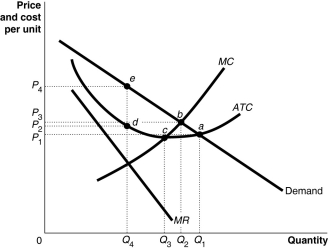
Refer to Figure 13-7.What is the profit maximizing output level?
A)Q1 units
B)Q2 units
C)Q3 units
D)Q4 units

Refer to Figure 13-7.What is the profit maximizing output level?
A)Q1 units
B)Q2 units
C)Q3 units
D)Q4 units

Unlock Deck
Unlock for access to all 143 flashcards in this deck.
Unlock Deck
k this deck
68
In the long run,if the demand curve of a monopolistically competitive firm is tangent to its average total cost curve then
A)the firm would break even.
B)the firm would shut down temporarily.
C)the firm would earn enough revenue to cover its variable costs,but not its fixed costs.
D)the firm would earn an economic profit.
A)the firm would break even.
B)the firm would shut down temporarily.
C)the firm would earn enough revenue to cover its variable costs,but not its fixed costs.
D)the firm would earn an economic profit.

Unlock Deck
Unlock for access to all 143 flashcards in this deck.
Unlock Deck
k this deck
69
If firms in a monopolistically competitive industry are making profits in the short run,
A)barriers to entry will be erected to keep out rivals.
B)some firms will ultimately exit the industry.
C)they will resort to advertising wars to help sustain these profits.
D)new firms will enter the market.
A)barriers to entry will be erected to keep out rivals.
B)some firms will ultimately exit the industry.
C)they will resort to advertising wars to help sustain these profits.
D)new firms will enter the market.

Unlock Deck
Unlock for access to all 143 flashcards in this deck.
Unlock Deck
k this deck
70
When new firms are encouraged to enter a monopolistically competitive market
A)some existing firms must be earning economic profits.
B)they do so because there is insufficient product differentiation.
C)the demand curve facing an existing firm shifts to the right.
D)the marginal cost curve facing an existing firm shifts downwards.
A)some existing firms must be earning economic profits.
B)they do so because there is insufficient product differentiation.
C)the demand curve facing an existing firm shifts to the right.
D)the marginal cost curve facing an existing firm shifts downwards.

Unlock Deck
Unlock for access to all 143 flashcards in this deck.
Unlock Deck
k this deck
71
If firms in a monopolistically competitive market are earning economic profits,which of the following scenarios best reflects the change a representative firm experiences as the market adjusts to its long-run equilibrium?
A)Demand decreases and becomes less elastic.
B)Demand decreases and becomes more elastic.
C)Demand increases and becomes less elastic.
D)Demand increases and becomes more elastic.
A)Demand decreases and becomes less elastic.
B)Demand decreases and becomes more elastic.
C)Demand increases and becomes less elastic.
D)Demand increases and becomes more elastic.

Unlock Deck
Unlock for access to all 143 flashcards in this deck.
Unlock Deck
k this deck
72
Figure 13-7 
Refer to Figure 13-7.Economies of scale are exhausted at which output level?
A)Q1 units
B)Q2 units
C)Q3 units
D)more than Q1 units

Refer to Figure 13-7.Economies of scale are exhausted at which output level?
A)Q1 units
B)Q2 units
C)Q3 units
D)more than Q1 units

Unlock Deck
Unlock for access to all 143 flashcards in this deck.
Unlock Deck
k this deck
73
Which of the following would not occur as a result of a monopolistically competitive firm suffering a short-run economic loss?
A)The firm could exit the industry in the long run.
B)If the firm does not exit the industry in the long run its demand curve will shift to the left.
C)If the firm does not exit the industry in the long run its demand curve will shift to the right.
D)If the firm remains in the industry in the long run it will break even.
A)The firm could exit the industry in the long run.
B)If the firm does not exit the industry in the long run its demand curve will shift to the left.
C)If the firm does not exit the industry in the long run its demand curve will shift to the right.
D)If the firm remains in the industry in the long run it will break even.

Unlock Deck
Unlock for access to all 143 flashcards in this deck.
Unlock Deck
k this deck
74
Figure 13-7 
Refer to Figure 13-7.What is the area that represents the firm's profit?
A)profit = 0
B)P4edP2
C)P4eaP1
D)P3baP2

Refer to Figure 13-7.What is the area that represents the firm's profit?
A)profit = 0
B)P4edP2
C)P4eaP1
D)P3baP2

Unlock Deck
Unlock for access to all 143 flashcards in this deck.
Unlock Deck
k this deck
75
Tony's Italian Ice is a monopolistically competitive firm.If Tony's earns a profit in the short run,which of the following is most likely to occur?
A)New firms that sell Italian ice will enter the market and Tony's cost curves will shift to the left.
B)New firms that sell Italian ice will enter the market and Tony's demand curve will shift to the left.
C)New firms that sell Italian ice will enter the market and Tony's demand curve will shift to the right.
D)New firms that sell Italian ice will enter the market and Tony's demand curve will become more inelastic.
A)New firms that sell Italian ice will enter the market and Tony's cost curves will shift to the left.
B)New firms that sell Italian ice will enter the market and Tony's demand curve will shift to the left.
C)New firms that sell Italian ice will enter the market and Tony's demand curve will shift to the right.
D)New firms that sell Italian ice will enter the market and Tony's demand curve will become more inelastic.

Unlock Deck
Unlock for access to all 143 flashcards in this deck.
Unlock Deck
k this deck
76
Figure 13-7 
Refer to Figure 13-7.If the diagram represents a typical firm in the market,what is likely to happen in the long run?
A)Some firms will exit the market causing the demand to increase for firms remaining in the market.
B)New firms will enter the market causing the demand to decrease for existing firms.
C)Inefficient firms will exit the market and new cost-efficient firms will enter the market.
D)Competition will be intensified as firms strive to make long-run profits.

Refer to Figure 13-7.If the diagram represents a typical firm in the market,what is likely to happen in the long run?
A)Some firms will exit the market causing the demand to increase for firms remaining in the market.
B)New firms will enter the market causing the demand to decrease for existing firms.
C)Inefficient firms will exit the market and new cost-efficient firms will enter the market.
D)Competition will be intensified as firms strive to make long-run profits.

Unlock Deck
Unlock for access to all 143 flashcards in this deck.
Unlock Deck
k this deck
77
Which of the following describes the relative positions of the demand curve and the average total cost (ATC)curve of a monopolistically competitive firm that earns a profit in the short run?
A)In the short run,the firm's demand curve will lie above its ATC curve.The demand curve will be tangent to the ATC curve in the long run.
B)In the short run,the firm's demand curve will lie below its ATC curve.The demand curve will be tangent to the ATC curve in the long run.
C)In the short run,the firm's demand curve will cross its ATC curve at the ATC curve's lowest point.The demand curve will be above the ATC curve in the long run.
D)In the short run,the firm's ATC curve will cross the demand curve at the profit maximizing level of output.The demand curve will be tangent to the ATC curve in the long run.
A)In the short run,the firm's demand curve will lie above its ATC curve.The demand curve will be tangent to the ATC curve in the long run.
B)In the short run,the firm's demand curve will lie below its ATC curve.The demand curve will be tangent to the ATC curve in the long run.
C)In the short run,the firm's demand curve will cross its ATC curve at the ATC curve's lowest point.The demand curve will be above the ATC curve in the long run.
D)In the short run,the firm's ATC curve will cross the demand curve at the profit maximizing level of output.The demand curve will be tangent to the ATC curve in the long run.

Unlock Deck
Unlock for access to all 143 flashcards in this deck.
Unlock Deck
k this deck
78
Figure 13-7 
Refer to Figure 13-7.What is the output price?
A)P4
B)P3
C)P2
D)P1

Refer to Figure 13-7.What is the output price?
A)P4
B)P3
C)P2
D)P1

Unlock Deck
Unlock for access to all 143 flashcards in this deck.
Unlock Deck
k this deck
79
Long-run equilibrium under monopolistic competition and perfect competition is similar in that
A)firms produce at the minimum point of their average cost curves.
B)price equals marginal cost.
C)firms break even.
D)price equals marginal revenue.
A)firms produce at the minimum point of their average cost curves.
B)price equals marginal cost.
C)firms break even.
D)price equals marginal revenue.

Unlock Deck
Unlock for access to all 143 flashcards in this deck.
Unlock Deck
k this deck
80
Figure 13-7 
Refer to Figure 13-7.If the diagram represents a typical firm in the market,what is likely to happen to its average cost of production in the long run?
A)It will probably fall since the firm must be cost efficient to remain competitive.
B)It will probably fall since the firm will be selling less than its current amount.
C)It will probably rise since the firm will be producing less than its current amount.
D)It will probably rise since its long-run demand is likely to be higher.

Refer to Figure 13-7.If the diagram represents a typical firm in the market,what is likely to happen to its average cost of production in the long run?
A)It will probably fall since the firm must be cost efficient to remain competitive.
B)It will probably fall since the firm will be selling less than its current amount.
C)It will probably rise since the firm will be producing less than its current amount.
D)It will probably rise since its long-run demand is likely to be higher.

Unlock Deck
Unlock for access to all 143 flashcards in this deck.
Unlock Deck
k this deck



